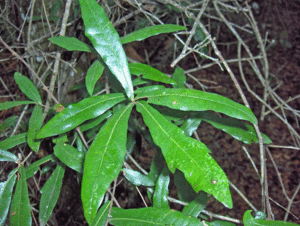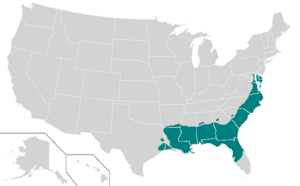Sand laurel oak facts for kids
Quick facts for kids Sand laurel oak |
|
|---|---|
 |
|
| Conservation status | |
| Scientific classification | |
| Genus: |
Quercus
|
| Species: |
hemisphaerica
|
 |
|
| Synonyms | |
|
List
Dryopsila maritima (Michx.) Raf.
Quercus geminata f. maritima (Michx.) Trel. Quercus hemisphaerica var. maritima (Michx.) C.H.Mull. Quercus laurifolia var. maritima (Michx.) A.E.Murray Quercus laurifolia subsp. maritima (Michx.) A.E.Murray Quercus maritima Raf. Quercus maritima (Michx.) Willd. Quercus nigra f. hemisphaerica (Bartram ex Willd.) Trel. Quercus phellos var. maritima Michx. Quercus virens var. maritima (Michx.) Chapm. Quercus virginiana var. maritima (Michx.) Sarg. |
|
The Quercus hemisphaerica, also known as the sand laurel oak, laurel oak, Darlington oak, or laurel-leaf oak, is a type of oak tree. It grows naturally in the southeastern and south-central parts of the United States. You can find it from Texas all the way to Delaware. This tree belongs to the red oak group, which is a big family of oaks.
People often mix up the sand laurel oak with another tree called the swamp laurel oak. Even though they look similar, they have some important differences.
Contents
What Does the Sand Laurel Oak Look Like?
The sand laurel oak is a medium-sized tree. It can be evergreen, meaning its leaves stay green all year. Sometimes, it's semi-evergreen, which means it loses its leaves for only a short time.
- Size: These trees can grow very tall, up to 115 feet (35 meters)! Their trunks can be as wide as 5 feet (1.5 meters). But usually, they are about 60 to 65 feet (18 to 20 meters) tall.
- Leaves: The leaves are smooth on the edges. They are shaped like an ellipse or a narrow oval. They are about 1.2 to 4.7 inches (3 to 12 cm) long. The leaves are also about 0.4 to 1.6 inches (1 to 4 cm) wide. The small stem that connects the leaf to the branch, called a petiole, is very short.
- Acorns: The acorns of the sand laurel oak are shaped like half a sphere. They are about 0.35 to 0.6 inches (9 to 16.5 mm) long and wide. It takes a long time for the acorns to grow, about 18 months! A small, saucer-shaped cap covers about a quarter to a third of the acorn.
Where Does the Sand Laurel Oak Grow?
This tree likes to grow in sandy soils that are a bit dry. You can often find it in sand hills or sometimes on the sides of hills.
Sand Laurel Oak vs. Swamp Laurel Oak: Key Differences
It can be tricky to tell the sand laurel oak from the swamp laurel oak. Here are some ways to tell them apart:
- Flowering Time: If both types of trees are in the same area, the sand laurel oak will bloom (flower) about two weeks later than the swamp laurel oak.
- Where They Grow: Sand laurel oaks prefer dry, sandy soils. Swamp laurel oaks, however, like wet places. They grow in flood plains, along river bottoms, or in soils that don't drain well.
- Leaf Shape: The sand laurel oak has narrow oval or elliptical leaves. The swamp laurel oak has leaves that are more diamond-shaped or broadly oval.
- Leaf Tips and Bases: The sand laurel oak's leaves have a pointed tip (acute) and a rounded or blunt base. The swamp laurel oak's leaves have a blunt or rounded tip and a narrow, wedge-shaped (cuneate) base.
- Leaf Retention: Most sand laurel oaks keep their leaves all year (evergreen). Swamp laurel oaks usually lose their leaves later in the season (tardily deciduous).
Hybrids
Sometimes, the sand laurel oak can mix with other oak species. One known hybrid is with the Turkey oak (Q. laevis). This mixed tree is called Q. × mellichampii.


